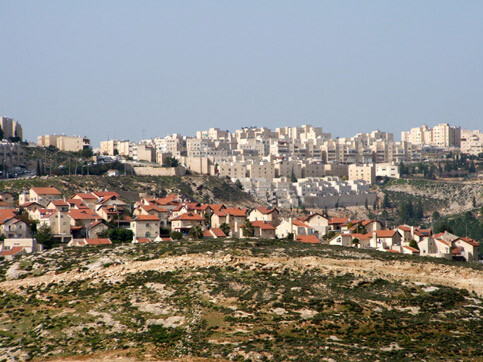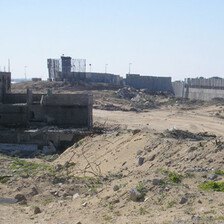Palestine Report 5 May 2005

The Israeli settlement Pisgat Zeev seen from the Palestinian village Hizma (Maureen Clare Murphy)
About one year ago, the Israeli settlement industry appeared to gain new life. “Much better than Jerusalem!” proclaims a sign advertising housing in New Adam, which lies just three kilometers from Pisgat Zeev and on Ramallah’s eastern shoulder. “Cottages and a garden for the price of an apartment.”
Real estate agents for Rimmonim entice wary buyers even deeper into the West Bank with promises of new villas and large gardens. It’s hard to believe, looking at these cheerful signs, that Israel’s prime minister worries out loud that these communities are ready to wage civil war.
Indeed, if the early years of the Palestinian uprising were lean times for the sellers of occupied land, since 2003, West Bank settlements have begun once again to expand beyond the annual five percent considered natural growth. “When the Intifada broke out, demand for housing in the invasive settlements of the West Bank declined and construction concentrated in areas closer to the Green Line,” explains Dror Etkes, coordinator of Peace Now’s Settlement Watch. “Now the real estate market has learned how to live with the new situation.” On the ground, there are no visible signs that the Israeli government has altered its policy of investing and expanding into the 1967 lands.
How then does one contextualize this right-wing Israeli government’s upcoming relocation of 8,650 West Bank and Gaza settlers? Prime Minister Ariel Sharon’s close advisor has described the disengagement plan as a means of preempting a political conclusion. “The disengagement is actually formaldehyde,” Dov Weisglass told Haaretz’s Uri Shavit in August. “It supplies the amount of formaldehyde that’s necessary so that there will not be a political process with the Palestinians.”
More specifically, the disengagement plan is intended to forestall international intervention and Israeli public dissension. As incomplete as Palestinians perceive the roadmap plan to be, this broadly accepted document talks about ending the occupation, establishing a viable Palestinian state, and incorporating an international framework outside the sole purview of the United States. “Sharon will fight with a few more settlers, everyone will say that is wonderful, and the roadmap will be discarded,” predicts Jeff Halper of the Israeli Committee Against House Demolitions. In the meantime, the strategic settlement project will grow.
There is no denying, however, that the removal of even one Israeli settlement will alter the contours of the Palestinian-Israeli conflict. Perhaps - as the settlers vigorously assert - it will set an influential precedent for Israel’s withdrawal from occupied territory. More certainly, Israel will have committed itself to demarcating the contours of the Palestinian ghetto. Already, the first lines have been drawn in the form of the walls, fences, guard towers and gates that make up the barrier Israel is constructing in the West Bank. “The settlers are probably right when they say that everything outside the fence will be slated for dismantlement,” says Etkes. “But they still can’t prove it.” The removal of the Gaza Strip settlements, in other words, will establish that Israel believes it does not belong there.
Because it will in effect set limits for the Israeli settlement enterprise, there are still Israelis (and many Palestinians) who believe the disengagement plan is just a ruse. After the plan was broached in 2004, analyst Yossi Alpher promised to eat his laptop if Ariel Sharon ever oversaw the removal of a single settlement from the West Bank or Gaza. Today he is less doubtful, but Hebrew University Professor Tanya Reinhart remains convinced that there will be no withdrawal. She points out that only weeks before the July disengagement is slated to begin, not a single settler has received compensation, and no temporary housing has been established. Now the Israeli government is discussing postponing the withdrawal for three weeks to dodge Jewish holidays, pushing it back to August. This week, talks to relocate the Gaza settlers near Ashkalon stalled, and an agreement will not be drafted by the May 10 deadline. As if to demonstrate official lack of conviction, the Israeli minister of agriculture proposed recently that the Gush Katif farmers be allowed to stay on past the redeployment to continue working in their valuable greenhouses.
If disengagement was born from a desire to deflect criticism from Israel, new opportunities for pointing the finger have presented themselves. In his last visit to Washington, Sharon reportedly told US President George W. Bush that President Mahmoud Abbas was a “disappointment,” returning to the Arafat-era refrain that no Palestinian partner exists.
Complicating matters, the secular nationalist Palestinian leadership is today in the uncomfortable position of preparing for much-needed elections that are certain to establish the rival Islamist faction Hamas as a leading political force in Palestinian civic life. Without those elections, Palestinian institutions will remain strategically paralyzed, and scorned by the public. But the incorporation of Hamas, named a terrorist group by both the United States and Europe, will also provide Israel with added leverage for pressuring the Palestinian leadership. Already Israeli officials are quietly telling diplomats that a Palestinian Authority that includes Hamas will be an outlaw government. It remains to be seen whether the international community will allow that to be an excuse for Israel to avoid acting at all.
“I suggest that the progress be slow,” Sharon told reporters at a Passover ceremony. “I’m not saying that it should be deliberately halted, but we must insist that commitments are thoroughly met and not waver even the tiniest bit about their need to prevent smuggling, prevent terror, dismantle the terror organizations and stop their military industrial activity. The Americans also don’t propose that we yield on these things.” But it was Weisglass himself who told Haaretz in November that the torpedoing of the disengagement plan would be cause for “everlasting regret.”
Etkes isn’t sure what Sharon is up to, but his money is on Sharon doing all he can to stall. “I think Sharon is buying time. He really doesn’t know what will be possible, and what will not be possible, and so he is just trying to wait and see.”
If the disengagement plan is ultimately completed successfully, analysts say it could be part of a larger plan to cede land and Palestinian population centers, without turning over meaningful control. In fact, says Halper, Sharon could ultimately withdraw from as much as 85 percent of the West Bank without abandoning any major settlement blocs, and without giving Palestinians the resources and access necessary to build a viable state.
“Imagine going to a prison in your country and asking to see a blueprint,” says Halper, using his favorite analogy. “It will appear to you at first that the prisoners are in control of 95 percent of the territory. But the truth is, it is possible to maintain control of that prison by controlling only as much as five percent of the property - the bars, the doors, and the barbed wire.”
He believes that Sharon might even find it politically useful to make one final offer: “Palestinians will get a state, but a state that has no development potential whatsoever.” If they refuse, then the Israeli government will once again declare the Palestinian leadership irrelevant, and continue to impose the borders on Palestinians that it desires.
“The fence is the minimum of what Sharon is willing to get out of this,” points out Etkes. Otherwise, the long-term plan is war. Every withdrawal is a withdrawal to the next starting point for negotiations.” The disengagement will be the first step in establishing Israel’s permanent borders, writes Sharon’s security advisor Ephraim Halevy. This change is driven by US interests in the region, he says, and will be completed over the next three years.
At the Qalandiya checkpoint just south of Ramallah, it is obvious that settlers, too, see the advantages of establishing a minimum border. Flying an orange Gush Katif flag, a car speeds its way through the crowded Palestinian intersection next to the eight-meter-high concrete wall that severs the town from its undeveloped hinterlands. Afterwards, the bearded driver shares a conspiratorial laugh with a kippa-wearing passenger in the back seat - no rocks through the windshield; in fact, they barely earned a curious glance.
Israelis once rarely used this intersection - it formerly connected Ramallah to the Palestinian village of al Ram, and to Jericho. It takes two settlers and a flash of clarity, however, to show how the intersection has been transformed. In less than a year, it will be the major thoroughfare connecting settlements to the east of Ramallah with their counterparts to the west, and on to Israel. A few years after that, this dusty passage will likely be lined with Israeli-owned shops emblazoned with Hebrew products and landscaped with irrigated flowering plants. On the other side of the wall, Palestinians will be standing in line, trying to get out.
Related links:






